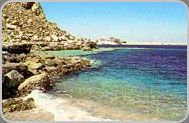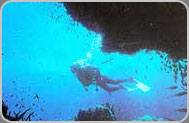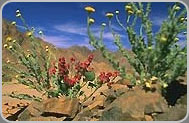|

 Abu Galum Managed Resource Protected Area Abu Galum Managed Resource Protected Area
 The Managed Resource Protected Area at Abu Galum, covering an area of 400 kilometers squared, protects varied coastal and mountain ecosystems unique on the Gulf of Aqaba. The area differs dramatically from the other Protectorates on the Gulf. The coastal area contains undisturbed coral reefs with high diversities of coral reef fish and associated flora and fauna. Evidence of the richness of the area can be seen on the shorelines covered with shells of various mollusk groups. The Managed Resource Protected Area at Abu Galum, covering an area of 400 kilometers squared, protects varied coastal and mountain ecosystems unique on the Gulf of Aqaba. The area differs dramatically from the other Protectorates on the Gulf. The coastal area contains undisturbed coral reefs with high diversities of coral reef fish and associated flora and fauna. Evidence of the richness of the area can be seen on the shorelines covered with shells of various mollusk groups.
Careful inspection of gravel beaches will reveal an abundance of the snail Nerita sp., their shells colored and patterned to blend perfectly with granitic or basaltic pebbles found on the beaches. The reef at Abu Galum supports an active Bedouin artisanal fishery. Fisherman from Nuweiba and Dahab practice subsistence fishing and also supply local restaurants with fish and shellfish products.
 The fishery is now being regulated by the EEAA to reduce damage to the coral reef. The reef can be viewed at marked, safe access entry points. Abu Galum is among the most picturesque Protectorates in the country. With its high mountains, narrow sinuous valleys (wadis), freshwater springs, coastal sand dunes, gravel alluvial fans, raised fossil coral reefs and low lying saline sabkha, its not surprising that this small area of the Sinai peninsula houses 165 plant species. The fishery is now being regulated by the EEAA to reduce damage to the coral reef. The reef can be viewed at marked, safe access entry points. Abu Galum is among the most picturesque Protectorates in the country. With its high mountains, narrow sinuous valleys (wadis), freshwater springs, coastal sand dunes, gravel alluvial fans, raised fossil coral reefs and low lying saline sabkha, its not surprising that this small area of the Sinai peninsula houses 165 plant species.
Of these, 44 species are seen only in this Protectorate and tend to increase in density towards central and northern Sinai. Researchers have suggested that Abu Galum is a floristic frontier falling under the influence of a tropical climate but having predominantly Mediterranean conditions. As a floristic frontier, the Abu Galum Protectorate is a sensitive area that receives a high conservation priority.
 Access to regions without vehicle track systems can only be permitted where marked trails have been prepared. Bedouin guides and camels can be hired if requests and arrangements are made at the ranger house located at the mouth of Wadi Rasasah. A visitor center will be located at the northern boundary of the Protectorate. Once completed, it will house a small audio-visual theater and displays concentrating on the flora and fauna of the Protectorate. Information on dive sites and areas to be avoided will be provided. It should be noted that access to the underwater caves at Ras Mamlah is strictly forbidden. Access to regions without vehicle track systems can only be permitted where marked trails have been prepared. Bedouin guides and camels can be hired if requests and arrangements are made at the ranger house located at the mouth of Wadi Rasasah. A visitor center will be located at the northern boundary of the Protectorate. Once completed, it will house a small audio-visual theater and displays concentrating on the flora and fauna of the Protectorate. Information on dive sites and areas to be avoided will be provided. It should be noted that access to the underwater caves at Ras Mamlah is strictly forbidden.
This cave system, extending to depths exceeding 100 meters, is unstable and deadly. Divers have been lost and not recovered from its depths.The main problem facing the Protectorate is the volume of floating garbage reaching its shores. Despite regular cleaning the problem persists.
|